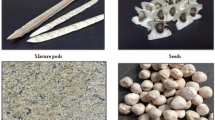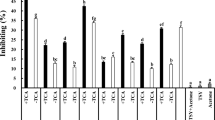Abstract
The rhizobacterium Paenibacillus macerans was grown in tryptic soy broth and after separating the cells by centrifugation the activity of fractions of the supernatant was tested against Meloidogyne exigua juveniles. From HPLC analyses and spectral data, the most active fractions were found to contain alanine, glutamic acid, glycine, histidine, threonine and valine, which were probably produced by bacterial hydrolysis of proteic nutrients. Amino acids from commercial sources were then assayed to confirm these results and to evaluate their potential for the control of nematodes. LC50 of 26 and 283 μg ml−1 were shown for the nematicide aldicarb and L-cysteine respectively when tested on M. exigua juveniles. At a concentration 38.4 times>LC50, the amino acid diminished the nematode population on coffee plants to values statistically equal to those obtained with aldicarb at a concentration 19.2 times>LC50.

Similar content being viewed by others
References
Ali, N. I., Siddiqui, I. A., Shaukat, S. S., & Zaki, M. J. (2002). Nematicidal activity of some strains of Pseudomonas spp. Soil Biology & Biochemistry, 34, 1051–1058. doi:10.1016/S0038-0717(02)00029-9.
Amaral, D. R., Oliveira, F. E. R., Oliveira, D. F., & Campos, V. P. (2003). Purification of two substances from bulbs of onion with nematicidal activity against Meloidogyne exigua Goeldi. Nematology, 5, 859–864. doi:10.1163/156854103773040763.
Barbosa, L. C. A., Barcelos, F. F., Demuner, A. J., & Santos, M. A. (1999). Chemical constituents from Mucuna aterrima with activity against Meloidogyne incognita and Heterodera glycines. Nematropica, 29, 81–88.
Bendzko, P., Etzel, W., Hoeding, B., Krebs, B., Maximov, J., & Ockardt, A. (1998). Cyclic peptide(s) from Bacillus amyloliquefaciens—useful as antimycotics, antivirals, fungicides, nematocides, etc. Germany Patent DE19641213-A1.
Boneti, J. I. S., & Ferraz, S. (1981). Modificação do método de Hussey e Barker para extração de ovos de Meloidogyne exigua de cafeeiro. Fitopatologia Brasileira, 6, 553.
Cronin, D., Moënne-Loccoz, Y., Fenton, A., Dunne, C., Dowling, D. N., & O’Gara, F. (1997). Role of 2,4-diacetilphloroglucinol in the interactions of the biocontrol Pseudomonas strain F113 with the potato cyst nematode Globodera rostochiensis. Applied and Environmental Microbiology, 63, 1357–1361.
Feldman, K., Peleg, I., & Handelman, J. H. (1999). New bacterial strains of species Bacillus firmus—have nematicidal activity, used for controlling plant pathogenic nematodes, particularly nematodes causing root-knot disease. Brazilian Patent BR9608204-A.
Ferreira, D. F. (2000). Statistical analysis through Sisvar for Windows 4.0 (Paper presented at the 45th Yearly Meeting of Brazilian Section of International Society Biometrics, São Carlos, Brazil).
Hussey, R. S., & Baker, K. R. (1973). A comparison of methods for collecting inocula of Meloidogyne spp. including a new technique. Plant Disease Reporter, 57, 1025–1028.
Lewis, S. A., & McClure, M. A. (1975). Free amino acids in roots of infected cotton seedlings resistant and suscepetible to Meloidogyne incognita. Journal of Nematology, 7, 10–15.
Oliveira, D. F., Campos, V. P., Amaral, D. R., Nunes, A. S., Pantaleão, J. A., & Costa, D. A. (2007). Selection of rhizobacteria able to produce metabolites active against Meloidogyne exigua. European Journal of Plant Pathology, 119, 477–479. doi:10.1007/s10658-007-9176-y.
Osman, G. Y. (1993). Effect of amino-acids and ascorbic acid on Meloidogyne javanica Chitw. (Tylenchidae, Nematoda). Anzeiger fur Schädlingskunde Pflanzenschutz Umweltschutz, 6, 140–142. doi:10.1007/BF01906844.
Osman, A. A., & Viglierchio, D. R. (1981). Foliar spray effects of selected amino acids on sunflower infected with Meloidogyne incognita. Journal of Nematology, 13, 417–419.
Reddy, P. P., Govindu, H. C., & Setty, K. G. H. (1975). Studies on the effect of amino acids on the root-knot nematode Meloidogyne incognita infecting tomato. International Journal of Nematology, 5, 36–41.
Regina, S. H., Etchegaray, A., Straus, A. H., Takahashi, H. K., Tersariol, I. L. S., Nader, H. B., et al. (1998). Purification of peptides and other biological compounds with highly substituted resins so far used for peptide synthesis (Paper presented at the 25th European Peptide Symposium, Budapest, Hungary).
Santos, J. M. (2000). Fatos e Feitos na História da Nematologia no Brasil e Principais Desafios para o Início do Novo Século (Paper presented at the 22th Brazilian Meeting of Nematology, Uberlândia, Brazil).
Scott, A. J., & Knott, M. A. (1974). A cluster analysis method for grouping means in the analysis of variance. Biometrics, 30, 507–512. doi:10.2307/2529204.
Setty, K. G. H., Krishnappa, K., & Prasad, K. S. K. (1977). Chemotherapeutic action of L- cysteine against root-knot nematode[Meloidogyne incognita (Kofoid and White)] Chitwood on tomato. Current Research, 6, 124–125.
Silvesrtein, R. M., Bassler, G. C., & Morrill, T. C. (1991). Spectrometric identification of organic compounds (5th ed.). New York: Wiley.
Talavera, M., & Mizukubo, T. (2005). Effects of DL-methionine on hatching and activity of Meloidogyne incognita eggs and juveniles. Pest Management Science, 61, 413–416. doi:10.1002/ps.974.
Acknowledgements
The authors are grateful to Conselho Nacional de Desenvolvimento Científico e Tecnológico (CNPq, Project number 372284/2006-0), Fundação de Amparo à Pesquisa do Estado de Minas Gerais (FAPEMIG, Project number EDT 573/05) and Coordenação de Aperfeiçoamento de Nível Superior (CAPES, Project number 0389056), for financial support and fellowships. The authors also express their sincere thanks to Prof. Eduardo M. Cilli for the HPLC analyses carried out at Araraquara Chemistry Institute-UNESP.
Author information
Authors and Affiliations
Corresponding author
Rights and permissions
About this article
Cite this article
Oliveira, D.F., Carvalho, H.W.P., Nunes, A.S. et al. The activity of amino acids produced by Paenibacillus macerans and from commercial sources against the root-knot nematode Meloidogyne exigua . Eur J Plant Pathol 124, 57–63 (2009). https://doi.org/10.1007/s10658-008-9392-0
Received:
Accepted:
Published:
Issue Date:
DOI: https://doi.org/10.1007/s10658-008-9392-0




